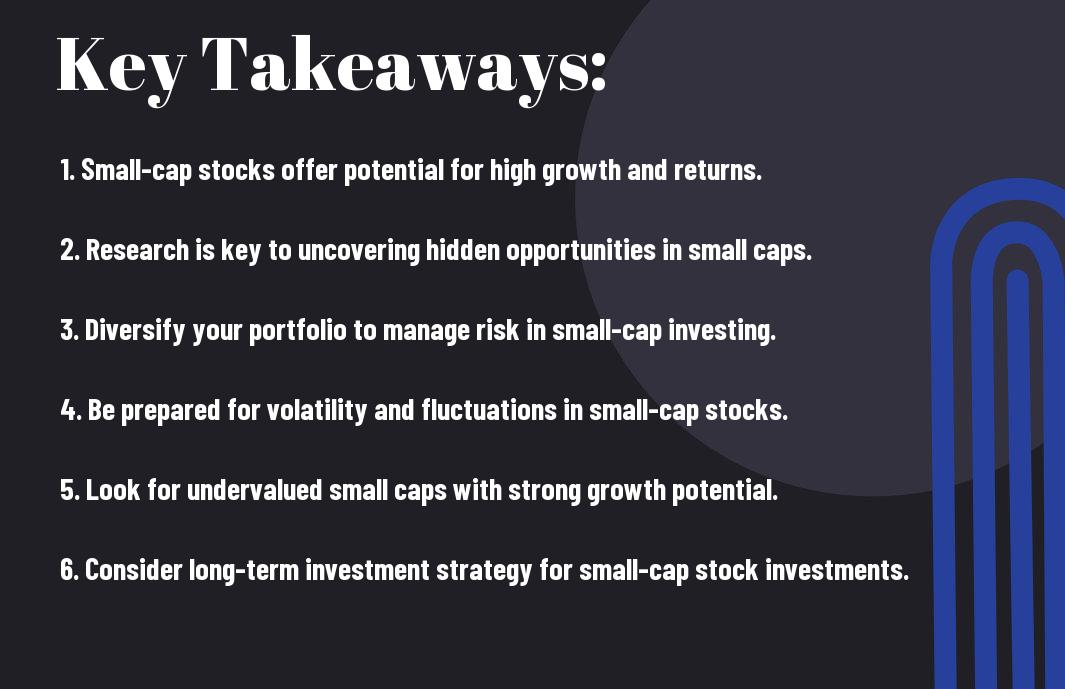It’s no secret that small-cap stocks have the potential to offer investors significant growth opportunities. These lesser-known companies, with market capitalizations typically ranging from $300 million to $2 billion, often fly under the radar of institutional investors, presenting a unique chance for individual investors to capitalize on their growth potential. However, investing in small-cap stocks also comes with its own set of risks that must be carefully assessed and managed. In this blog post, we will explore the potential of investing in small-cap stocks, uncovering hidden growth opportunities while considering the various risk factors involved.
Key Takeaways:
- Diversification: Small-cap stocks can add diversification to a portfolio, as they tend to be less correlated with larger-cap stocks.
- Growth potential: Small-cap companies have greater potential for growth compared to larger, more established companies, as they are in the early stages of development.
- Risk assessment: Small-cap stocks come with higher risk due to their volatility and susceptibility to market fluctuations, so thorough research and analysis are crucial before investing.
- Hidden gems: Investing in small-cap stocks can uncover hidden gems with untapped potential, providing opportunities for significant returns on investment.
- Long-term perspective: Patience is key when investing in small-cap stocks, as the growth of these companies may take time to materialize. Investors should have a long-term perspective and hold onto their investments through market fluctuations.

Understanding Small-Cap Stocks
Some Small-Cap Stocks: Uncovering the Secrets to High Growth Returns are often overlooked in the investment world, yet they hold the potential for high returns and hidden growth opportunities. These stocks belong to companies with relatively small market capitalization, typically ranging from $300 million to $2 billion. Small-cap stocks can offer investors the chance to capitalize on emerging trends and innovative ideas in the market.
Definition and Classification
Any investor looking to diversify their portfolio and seek higher returns should consider small-cap stocks as a part of their investment strategy. These stocks are often classified based on their market capitalization, with small-cap companies being at the lower end of the spectrum. While they may carry higher volatility and risk compared to larger-cap stocks, small-cap companies have the potential for rapid growth and can outperform the broader market over the long term.
Characteristics of Small-Cap Companies
For investors interested in small-cap stocks, it’s important to understand the unique characteristics of these companies. Small-cap companies typically have a market capitalization between $300 million and $2 billion, which means they are less established and may not have the same level of resources as larger companies. Despite this, small-cap companies often exhibit higher growth potential, driven by their ability to capitalize on niche markets, innovative products, or disruptive technologies.
It is important to note that small-cap stocks can be more volatile and carry higher risk than larger-cap stocks. However, their growth potential and ability to outperform the market make them an attractive option for investors seeking higher returns. Investors should conduct thorough research and due diligence to identify promising small-cap stocks with strong growth prospects and assess the risk factors associated with investing in these companies.
Identifying Growth Opportunities in Small-Cap Stocks
Sectors with High Growth Potential
Any investor looking to uncover hidden growth opportunities in small-cap stocks should consider sectors that show high growth potential. Industries such as technology, healthcare, and consumer discretionary have historically exhibited strong growth in small-cap stocks. For example, according to industry data, the technology sector has seen an average annual return of 12% over the past decade, making it an attractive choice for investors seeking growth opportunities.
Analyzing Financial Statements for Growth Indicators
Any investor seeking to identify growth opportunities in small-cap stocks should pay close attention to financial statements for key growth indicators. By analyzing metrics such as revenue growth, earnings per share, and return on equity, investors can gain valuable insights into the company’s growth potential. For instance, a company with consistently increasing revenue and earnings per share may indicate strong growth prospects, making it an attractive investment opportunity.
Opportunities in the small-cap space often lie in companies that have yet to be fully recognized by the market for their growth potential. By adeptly analyzing financial statements and identifying key growth indicators, investors can uncover hidden opportunities in small-cap stocks that have the potential to deliver significant returns.
Assessing Risk Factors in Small-Cap Investing
Now, when delving into small-cap stock investing, it is imperative to thoroughly assess and understand the associated risk factors. These investments offer promising growth opportunities, but they also come with their own set of unique challenges that investors need to navigate carefully to maximize returns and manage risks effectively.
Market Volatility and Liquidity Concerns
Volatility and liquidity are two major risk factors that investors need to consider when investing in small-cap stocks. Small-cap companies tend to be more sensitive to market fluctuations due to their size and limited resources. This can lead to increased price volatility, making these stocks riskier compared to their large-cap counterparts. Additionally, liquidity concerns may arise as small-cap stocks often have lower trading volumes, which can make it challenging to enter or exit positions swiftly without impacting prices. To learn more about managing these risks, check out Small cap investing: Uncovering Hidden Gems through Active Strategies.
The Impact of Economic Cycles on Small-Cap Stocks
On the other hand, economic cycles can significantly impact the performance of small-cap stocks. During economic downturns, small-cap companies may face greater financial challenges, such as limited access to capital and decreased consumer demand. This can lead to higher volatility and increased risk of business failure for small-cap stocks. As an investor, understanding how economic cycles influence small-cap stocks can help you make informed decisions and mitigate potential risks.
Stocks in the small-cap segment can offer substantial growth potential but also carry inherent risks that investors must carefully consider and manage. By evaluating factors such as market volatility, liquidity concerns, and the impact of economic cycles, investors can make more informed decisions to optimize their small-cap investment strategy.

Strategic Approaches to Small-Cap Investing
The Value Approach
All investors should consider employing a value-based approach when it comes to investing in small-cap stocks. This strategy involves identifying undervalued assets that have the potential for future growth. By conducting thorough research and fundamental analysis, investors can uncover hidden gems in the small-cap space that are trading below their intrinsic value. This approach can help mitigate risk and provide opportunities for significant returns over time.
The Growth Approach
With the growth approach, investors focus on companies with strong growth potential that are poised to outperform the market. Small-cap stocks offer unique opportunities for growth due to their ability to rapidly expand and capitalize on emerging trends. By identifying companies with solid revenue growth, innovative products or services, and a competitive edge in their industry, investors can benefit from the exponential growth potential of small-cap stocks.
To fully capitalize on the growth potential of small-cap stocks, investors should diversify their portfolio across various sectors and industries. This can help mitigate risk and maximize returns by spreading investments across different growth opportunities. Additionally, staying informed about market trends, industry developments, and economic factors can help investors make informed decisions and identify promising small-cap stocks for long-term growth.
Diversification and Portfolio Management
Balancing Risk and Reward with Portfolio Diversification
To manage risk and enhance potential returns when investing in small-cap stocks, diversification is key. By spreading your investments across a range of small-cap stocks in different industries and sectors, you can reduce the impact of any single stock’s performance on your overall portfolio. In this way, you can increase the likelihood of capturing growth opportunities while minimizing potential losses.
Position Sizing and Risk Management
Position sizing plays a crucial role in managing risk and optimizing returns in small-cap stock investments. It involves determining the appropriate allocation of capital to each stock in your portfolio based on factors such as the stock’s volatility, your risk tolerance, and overall portfolio diversification. By carefully sizing your positions, you can effectively manage risk and maintain a balanced portfolio that maximizes growth potential.
The goal of position sizing and risk management is to strike a balance between taking calculated risks to capture growth opportunities and protecting your capital from significant losses. By implementing sound risk management strategies, such as setting stop-loss orders and regularly reviewing your portfolio allocations, you can ensure that your investments in small-cap stocks are aligned with your financial goals and risk tolerance.
Long-Term vs. Short-Term Investment Strategies
Once again, it is imperative to consider the different investment strategies when delving into the world of small-cap stocks. For a comprehensive understanding of this topic, I recommend listening to the podcast episode ‘Small But Mighty: Uncovering Smallcap Value with Paul …’ for valuable insights. When deciding between long-term and short-term investment strategies, it is crucial to weigh the pros and cons of each approach to make informed decisions in small-cap investing.
Pros and Cons of Each Strategy in Small-Cap Investing
| Strategy | Pros and Cons |
| Long-Term Investment |
Stability in market fluctuations Potential for compounding returns |
| Short-Term Investment |
Opportunity for quick profits Higher volatility and risk exposure |
Timing the Market: Challenges and Techniques
On the subject of timing the market in small-cap stocks, challenges and techniques abound. It is crucial to understand the nuances of market timing and implement strategies that align with your investment goals. Investors must navigate through the fluctuations of small-cap stocks with precision and caution to maximize returns and mitigate risks effectively.
Prospecting in the small-cap market can be highly rewarding if approached with a sound strategy. By identifying growth opportunities and assessing risk factors meticulously, investors can unlock the potential for substantial returns in this dynamic investment landscape.
Tools and Resources for Small-Cap Stock Investors
Utilizing Screeners and Analytical Platforms
One of the key tools at the disposal of small-cap stock investors is the use of screeners and analytical platforms. These tools can help investors identify promising small-cap stocks based on specific criteria such as market capitalization, earnings growth, and valuation metrics. By using screeners, investors can narrow down their search to a manageable list of potential investment opportunities, saving time and effort in the process. Analytical platforms also provide in-depth analysis and insights into the financial health and growth potential of small-cap companies, helping investors make more informed decisions.
Staying Informed: Research and Financial News
Research and staying informed about market developments and financial news are crucial for small-cap stock investors. This involves regularly monitoring company announcements, industry trends, and macroeconomic factors that could impact small-cap stocks. By staying informed, investors can better assess risks and opportunities, and make timely investment decisions. Subscribing to reputable financial news sources and following market experts can provide valuable insights and guidance for navigating the dynamic small-cap stock market.

Regulatory Environment and Compliance
Understanding the Regulatory Framework for Small-Cap Stocks
Despite the potential for high growth in small-cap stocks, investors must be aware of the regulatory environment in which these stocks operate. Small-cap stocks are subject to a myriad of regulations set forth by governing bodies such as the Securities and Exchange Commission (SEC) and other regulatory authorities. Understanding these regulations is crucial for investors looking to capitalize on growth opportunities while mitigating risks.
Navigating Through Compliance Requirements
On the journey of investing in small-cap stocks, navigating through compliance requirements is a critical aspect that should not be overlooked. Compliance regulations for small-cap stocks are designed to protect investors and ensure transparency in the financial markets. For investors, staying on top of compliance requirements can be a challenging task, but it is necessary for maintaining the integrity of investments and safeguarding against potential risks.
For investors looking to investigate into small-cap stocks, it is imperative to conduct thorough due diligence on the compliance requirements relevant to these stocks. This may involve analyzing financial statements, regulatory filings, and understanding the implications of various compliance regulations on investment decisions. By proactively addressing compliance requirements, investors can position themselves for success and navigate the complex regulatory landscape with confidence.
Plus, being well-informed about compliance requirements can also enhance the credibility of an investor in the eyes of regulatory authorities and other market participants, ultimately fostering trust and credibility within the investment community.

Summing up
Conclusively, investing in small-cap stocks can present lucrative growth opportunities for investors willing to take on higher levels of risk. These stocks have the potential to outperform larger companies and provide substantial returns over time. However, it is important for investors to thoroughly research and assess the risk factors associated with small-caps before making any investment decisions. By carefully analyzing financial data, market trends, and company fundamentals, investors can uncover hidden growth opportunities and make informed choices to build a diversified investment portfolio. Despite the inherent volatility and uncertainty of small-cap stocks, a strategic approach to investing in this sector can lead to significant financial gains in the long run.




